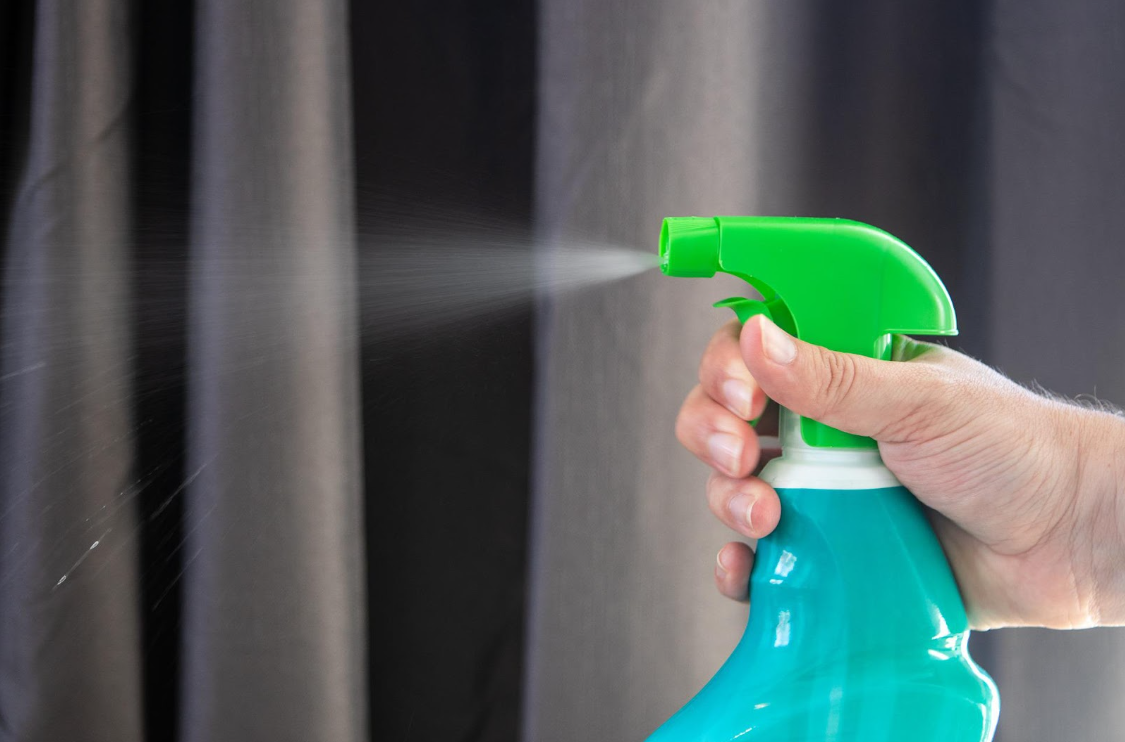Unlike with cosmetics and sanitary products, with cleaning detergents we very often see labels such as corrosive, dangerous to eyes, dangerous to skin, to aquatic life, and many others. Since it is not expected that we put these products on our skin, some can contain very toxic chemicals.

Picture source: pixabay.com
It is true that in most cases, we are not putting them on our skin, however, it is likely that we touch them while cleaning, we breathe them in or they stay on our dishes or washed clothes. In the absolute worst case our child finds them and drinks or plays with them.
In our article about cleaning with vinegar, we show you that many of these can be easily exchanged with a much healthier alternative. In this article we show you what are some of these horrible chemicals and hopefully you will be motivated to move away from them even faster.
These are labels you can come across on your cleaning product packaging. As you can see, even chemicals that can cause serious health hazards or acute toxicity find its way into our products.

Picture source: https://echa.europa.eu/sk/regulations/clp/clp-pictograms
Producers are legally obliged to indicate these warning labels, they are however, not obliged to disclose all the ingredients that are in their product. And they very rarely do so, on the packaging we usually find only a small part of the ingredients, which is scary, because then we actually have no idea what is in the product.
Producers should also provide a Safety Data Sheet (an SDS) when they sell chemicals. And believe it or not, cleaning detergents are full of chemicals and you could in fact request an SDS from the producer.
A Safety Data Sheet (SDS) is a collection of information on the properties of each chemical and its physical, health, and environmental health hazards. SDS information may include protective measures; instructions for safe use and storing.
But there is also another point to consider, while our cleaning products shouldn’t have any immediate effects on our health, what about the long term effect of us using these products regularly? Effects that you will unfortunately never find on the labels…
VOCs – examples include formaldehyde, limonene, toluene, acetone, ethanol (ethyl alcohol) 2-propanol (isopropyl alcohol), hexanal
The problem with cleaning products is that they often come in the form of sprays and even if not, they are heavily scented to give us the feeling of a “clean and fresh” smelling household. But at what price? Spray mist is inhaled automatically as is the scent of our cleaning product, and it is not good for us. Let’s have a look at some research, which if you do not like to clean so much, will surely make you smile.
Here is a statement that you should not show to your messy teenage child: People who clean a lot have significantly weaker lungs than people who never clean.
This is the conclusion of a Norwegian study which examined 6,230 individuals over a period of 20 years. The participants of this “Respiratory Health Survey” were 34 years old on average and have been cleaning regularly or full-time. After the completion of the 20 year old experiment, scientists were able to determine a significant damage in the function of the lungs. Full-time cleaners had the greatest decline in lung function [1], [2].
Another research was conducted in Canada in the homes of 14 volunteers. This test was focused on indoor air quality. It was discovered that by cleaning with conventional products, the air quality significantly decreases. Volatile organic compounds, VOCs for short, are found in many various cleaning products, cause air pollution and have been identified as a risk to human health.
VOCs’ harmful effects include eye, nose, mouth and throat irritation, headaches, skin problems and asthma. Based on a few studies on VOCs, children and infants are especially vulnerable and can suffer from respiratory, allergic or immune problems as well as have an increased risk of asthma. Exposure to VOCs when pregnant is also potentially a big risk as pregnant women have a heightened sensitivity to such chemicals and exposure can lead to low birth weights [3].
To actually give you an imaginable comparison, if you were to mop indoors with a freshly scented cleaning product, it would produce as much pollution as cars on a busy street! The tiny particles that are released can cause harmful health effects as already mentioned above.
Limonene
A specific molecule that needs to be brought up and is of concern is limonene. This substance is added to cleaners and polishes to help get rid of oil and grease and it adds a citrusy scent. The problem with limonene is when it gets mixed with ozone, which is an outdoor pollutant. This reaction causes the molecules to turn into peroxides and alcohols. These small particles can then enter the lungs and irritate the cells, causing asthma if the exposure is high. In the worst cases it can even lead to heart attacks and strokes [4].
Fun fact; in Canada, people spend around 200 to 300 dollars annually on products that are expected to sustain a clean and healthy home, while in fact they could be doing the exact opposite. In Germany it’s around 120 euro annually [3], [5].
Ammonia
Another chemical used in many cleaning products that can be harmful for lungs is ammonia. For the safest use of cleaning products with ammonia, make sure to follow all instructions on the product’s label, while wearing suitable clothes and eye protection and having the area properly ventilated. Exposure to ammonia can harm the skin, eyes, is toxic if inhaled and if swallowed, can burn the mouth, throat and stomach, causing serious abdominal pain [6].
According to the ECHA classification, ammonia is very toxic to aquatic life with long lasting effects [7].
Bleach
If we talk about ammonia, we have to mention bleach as well, as both of these chemicals are some of the most recognized cleaning ingredients out there. The first thing to remember is to never mix ammonia with chlorine bleach. This chemical merger releases toxic gasses called chloramines and exposure to such gasses can trigger coughing, shortness of breath, chest pain, nausea or irritation [6].
Fumes coming from bleach alone contain a mix of toxic, carcinogenic and irritating gasses and repeated exposure has been connected to respiratory problems.
Another important fact is that bleach was the most common cause of poisoning or injury at homes, as was shown in a research done in America. Overall, in 2010, they counted more than 116,000 calls about household cleaner accidents involving children under age five [8].
Borax or boric acid
Borax is also important to mention because it is often recommended in DIY homemade recipes for laundry or dishwashing detergents. People who actually want to create environmentally friendly and health safe products are unknowingly using this powdery white mineral. A close cousin of borax is boric acid, which is a pesticide that kills insects and weeds [8].
This should already give us a clue that it might not be the safest substance. According to the ECHA classification, borax may have negative effects on fertility or the unborn child [9].
Disinfectants
Last but not least, something which should definitely be mentioned, especially now in COVID times where everyone is obsessed with antibacterial and antiviral cleaners, are disinfectants.
Environmental medicine and hygiene experts advise against the use of antibacterial cleaners in private households as studies have shown that cleaning your home with these cleaners results in more illnesses occurring.
Antibacterial cleaners consist of aggressive substances and their effect is only short-term. In a normal environment, the bacteria is back after a few minutes. In addition, it is very important for small children to strengthen their immune system to fight illnesses through contact with bacteria that are normally present in the house [10].
You can read more about the chemicals and dangerous substances in disinfectants in our article dedicated to antibacterial products.
But don’t lose hope. There are already so many alternatives to cleaning products and many of them work as good as their chemical brothers.
If you change from conventional to green cleaning products, you can significantly decrease air concentrations of dangerous chemicals. As this study measured, chemicals which are classed as carcinogens, reproductive/developmental toxicants or endocrine disruptors significantly decreased when participants switched to green cleaning products. Some as much as 86.7%. Yet, 98% of all participants confirmed that the green products worked as well as their original products [11].
Sources
[1]https://www.ndr.de/ratgeber/gesundheit/Putzmittel-Gefahr-fuer-Lunge-und-Haut,putzmittel134.html
[3]https://environmentaldefence.ca/wp-content/uploads/2016/01/TheDirtyTruth_ENG.pdf
[4]https://www.science.org/content/article/mopping-can-create-air-pollution-rivals-city-streets
[6]https://www.chemicalsafetyfacts.org/ammonia/
[7]https://echa.europa.eu/sk/substance-information/-/substanceinfo/100.028.760
[8]https://www.ewg.org/guides/cleaners/content/cleaners_and_health/
[9]https://echa.europa.eu/sk/substance-information/-/substanceinfo/100.129.152


0 Comments